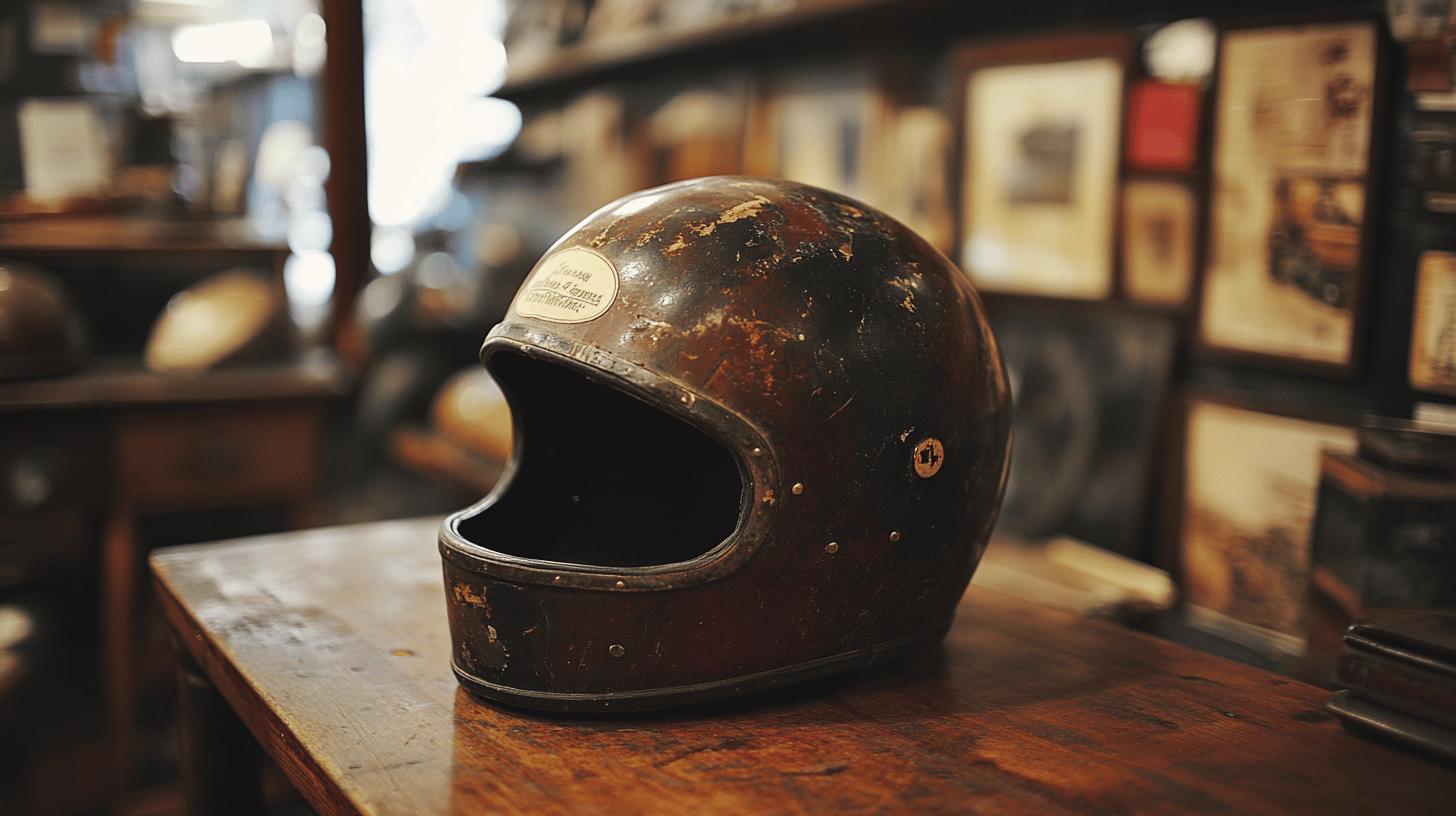Ever pondered how motorcycle helmets became a staple for every rider? This vital piece of gear traces its origins back to 1914, marking a pivotal shift in rider safety. Despite the early invention, it wasn't until T.E.
Lawrence's tragic accident in 1935 that the motorcycle community realized the crucial role helmets play in safeguarding lives. His untimely death underscored the importance of head protection, eventually leading to widespread helmet adoption among motorcyclists.
Join us as we delve into the fascinating journey of the first motorcycle helmet and the key figures behind its inception.
The Invention of the First Motorcycle Helmet

When was the motorcycle helmet invented? The motorcycle helmet was invented in 1914. This marked a significant milestone in the evolution of motorcycle safety gear, responding to the increasing need for rider protection as motorcycles became more prevalent.
A pivotal figure in the history of the first motorcycle helmet was Dr. Eric Gardner, a British doctor who recognized the need for head protection after observing the injuries sustained by Isle of Man TT racers. His advocacy led to the creation of the first helmet, designed to protect riders from traumatic head injuries during races.
A defining moment in helmet history was the fatal accident of T.E. Lawrence, famously known as 'Lawrence of Arabia,' in May 1935. His crash highlighted the dangers of riding without a helmet, bringing public attention to the importance of head protection.
This tragic event significantly influenced the adoption of helmets among motorcyclists, sparking a movement towards standardizing helmet use for improved safety.
The aftermath of Lawrence's death saw Sir Hugh Cairns, an Australian neurosurgeon, conducting research and advocating for the widespread use of helmets. His efforts underscored the necessity of head protection and played a critical role in changing public perception and encouraging helmet adoption, paving the way for future advancements in helmet technology and safety standards.
Evolution of Motorcycle Helmet Technology

When did motorcycle helmet technology begin to evolve significantly? The evolution of motorcycle helmet technology began significantly after World War II, with the emergence of specialized helmet manufacturers.
The technological advancements in motorcycle helmet design have been remarkable since their inception. Post-war developments saw the introduction of innovative materials and designs that transformed helmet safety and comfort. Key advancements include the use of lightweight materials such as carbon fiber and Kevlar composites, which offer exceptional impact resistance and durability, enhancing rider safety.
The shift from primitive leather and cork helmets to more advanced designs has been driven by the need for better protection and comfort. The introduction of impact-absorbing polystyrene liners marked a turning point, providing enhanced shock absorption during collisions.
Modern helmets integrate advanced aerodynamics, venting systems, and communication technologies, catering to contemporary riders' needs for both safety and convenience. These features not only improve the protective capabilities of helmets but also enhance the overall riding experience.
Here are five key technological milestones in helmet development:
-
1947: Establishment of specialized helmet manufacturers, such as AGV in Italy, focusing on improved safety designs.
-
1950s: The introduction of impact-absorbing polystyrene liners, offering better shock absorption.
-
1970s: Use of fiberglass in helmet shells, providing a balance of strength and weight reduction.
-
1980s: Adoption of Kevlar composites for enhanced impact resistance and lightweight design.
-
2000s: Integration of electronic systems, including Bluetooth and communication devices, into helmet design for modern riding needs.
These milestones highlight the continuous efforts to improve helmet safety and comfort, reflecting the industry's commitment to protecting riders. The progression from basic protective gear to sophisticated safety equipment underscores the crucial evolution of motorcycle helmet technology over the decades.
Historical Impact of Helmets on Motorcycle Safety

How have helmets impacted motorcycle safety historically? Helmets have been pivotal in reducing injuries and fatalities in motorcycle accidents. Their role in safety was underscored by the death of T.E. Lawrence, also known as 'Lawrence of Arabia,' in 1935. This tragic event highlighted the dire need for head protection, catalyzing the normalization of helmet use among motorcyclists.
The accident of T.E. Lawrence was a crucial turning point in helmet history. His fatal crash brought public awareness to the dangers faced by riders without head protection. This incident emphasized the importance of helmets and led to increased efforts to promote their use, aiming to prevent similar tragedies.
One of the key figures in advocating helmet use was Sir Hugh Cairns, an Australian neurosurgeon. Recognizing the potential life-saving benefits of helmets, Cairns conducted comprehensive research on the effects of traumatic head injuries in motorcyclists. His studies provided compelling evidence that wearing helmets could substantially decrease the risk of severe brain injuries.
Sir Hugh Cairns' advocacy significantly influenced public perception and policy regarding helmet use. His work contributed to the introduction of helmet safety standards and regulations, making helmets a mandatory piece of safety gear in various regions. These efforts not only encouraged more riders to wear helmets but also paved the way for future advancements in helmet technology and design.
The post-World War II era saw the rise of specialized helmet manufacturers, which further propelled helmet adoption. Companies like AGV in Italy began producing helmets that met higher safety standards, boosting their availability and acceptance among riders. This period marked a shift towards improved helmet designs, incorporating better materials and safety features.
The historical impact of helmets on motorcycle safety can be summarized through these significant events:
| Event | Impact on Helmet Use |
|---|---|
| T.E. Lawrence’s Accident | Spurred helmet awareness |
| Sir Hugh Cairns’ Advocacy | Led to increased helmet adoption |
| Post-WWII Helmet Manufacturing | Boosted helmet availability and use |
These milestones illustrate the critical role helmets have played in enhancing motorcycle safety, highlighting the ongoing efforts to protect riders from head injuries and fatalities.
Development of Helmet Safety Standards

When did motorcycle helmet standards begin to develop? The development of motorcycle helmet standards began in the mid-20th century as the popularity of motorcycles soared. Safety standards became essential to ensure helmets provided adequate protection for riders.
Motorcycle helmet standards have evolved significantly over the years. Initially, helmets were designed with basic protection in mind, often tested informally. As the motorcycle industry expanded, the need for formalized helmet testing standards and certifications became apparent. These standards were established to ensure helmets could withstand impacts and provide reliable protection against head injuries.
The introduction of helmet safety certifications has led to substantial improvements in helmet design and manufacturing. Modern helmets are subject to rigorous testing protocols to meet specific safety criteria.
These tests simulate real-world crash scenarios to assess the helmet's ability to absorb impact and protect the rider's head. As a result, helmets today offer superior protection compared to their early counterparts.
Four major safety certifications for motorcycle helmets include:
-
DOT (Department of Transportation):
-
Required in the United States, ensuring helmets meet minimum safety performance standards.
-
Tests include impact attenuation, penetration resistance, and retention system effectiveness.
-
ECE 22.05 (Economic Commission for Europe):
-
Mandatory in over 50 countries, focusing on impact absorption, penetration resistance, and chin strap efficiency.
-
Known for comprehensive testing procedures and high safety standards.
-
Snell Memorial Foundation:
-
A voluntary certification known for its rigorous testing and high safety benchmarks.
-
Evaluates helmets for impact resistance, face shield penetration, and retention system strength.
-
SHARP (Safety Helmet Assessment and Rating Program):
-
A UK-based rating system providing safety performance scores from one to five stars.
-
Assesses helmets based on independent impact tests and provides consumers with comparative safety information.
These certifications have played a pivotal role in enhancing helmet safety and building consumer confidence. By adhering to these standards, manufacturers are able to produce helmets that not only meet safety requirements but also incorporate advanced materials and designs for improved rider comfort and protection.
The Role of Helmets in Modern Motorcycle Culture

Helmets have become an indispensable part of modern motorcycle culture, representing not only a commitment to safety but also a statement of style and identity. How have helmet adoption trends evolved over time? The widespread adoption of helmets is largely attributed to increased safety awareness and technological advancements. Riders now recognize the critical role helmets play in reducing the risk of head injuries, which has significantly influenced their adoption.
What impact do helmets have on motorcyclists' safety? Helmets are crucial in protecting riders from severe head injuries during accidents. Their design has evolved to incorporate advanced materials like carbon fiber and Kevlar, which enhance impact resistance and comfort. Modern helmets also feature integrated technologies such as Bluetooth communication systems, catering to the needs of contemporary riders and promoting their use.
The importance of helmet safety cannot be overstated. Helmets have become a legal requirement in many regions, further boosting their adoption. This legal backing, combined with the evident safety benefits, has led to a cultural shift where helmets are not just protective gear but also a symbol of responsible riding.
Beyond safety, helmets hold cultural significance in the motorcycle community. They serve as a canvas for personal expression, with riders customizing designs to reflect their personalities and affiliations. This blend of safety and style has cemented helmets' place in the motorcycling world.
A real-world example highlighting the cultural and safety significance of helmets is Valentino Rossi, a renowned professional motorcycle racer. Rossi is known for his distinctive helmet designs that often feature vibrant colors and unique graphics, making them iconic in the racing community.
His advocacy for helmet use underscores their importance in protecting riders and enhancing the sport's safety standards. Rossi's influence extends beyond the track, inspiring both casual and professional riders to prioritize helmet safety while embracing their individuality.
Final Words
Motorcycle helmets have evolved significantly since their invention in 1914, underscoring the importance of safety in riding. The tragic accident of T.E. Lawrence highlighted their necessity and led to widespread adoption.
Advancements in materials and technology have continually improved helmet safety and comfort, reflecting their vital role in reducing injuries and fatalities. As helmets remain a crucial aspect of modern motorcycle culture, their history and development continue to enhance every rider’s safety.
FAQ
Who invented the helmet for a motorcycle?
The motorcycle helmet was first invented in 1914 by Dr. Eric Gardner. His pioneering design marked a significant advancement in rider safety. Its development became pivotal after T.E. Lawrence's 1935 accident highlighted helmet importance.
When was the first helmet used in sports?
The first helmet used in sports appeared in the early 20th century. Its adoption grew with increasing awareness of the benefits in protecting athletes during physical activities, especially in motorcycling.
When did motorcyclists start wearing helmets?
Motorcyclists began adopting helmets more routinely after T.E. Lawrence's tragic accident in 1935. This event catalyzed public awareness about head protection during riding, influencing helmet use across motorcyclist communities.
Who invented the helmet for a bike?
The bike helmet, focusing on protecting cyclists, evolved separately from the motorcycle helmet. Its exact inventor is ambiguous, but awareness of the importance intensified mid-20th century, similar to motorcycles.
Where was the HJC helmet company founded?
HJC, a leading helmet manufacturer, was founded in South Korea. Established in the early 1970s, they specialize in producing quality helmets for motorcyclists worldwide.
What is the oldest helmet brand?
AGV, an Italian helmet manufacturer, is one of the oldest brands founded in 1947. Known for pioneering helmet technology, they remain influential in the industry.
When were full-face motorcycle helmets invented?
Full-face helmets were developed in the 1960s, offering comprehensive protection. This design innovation significantly enhanced rider safety, contributing to their popularity and widespread use in racing and daily riding.
What does the E13 helmet certification mean?
The E13 certification indicates compliance with specific safety standards for helmets sold in Europe. It assures consumers that the helmet has passed rigorous testing for impact resistance and shell durability.

Mark Anderson is a trusted expert with over 25 years of riding experience. At 56, his deep knowledge of long-distance touring and participation in major motorcycle rallies makes him a reliable source for gear recommendations on ProtectiveGearz. Mark’s decades of firsthand experience ensure his advice is authoritative and valuable to riders seeking expert guidance.



